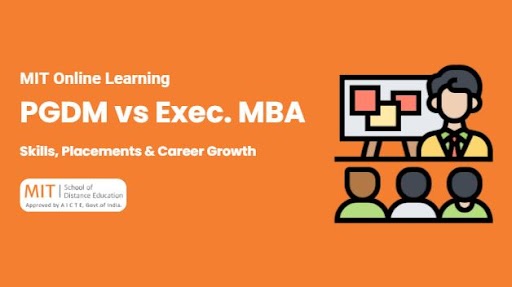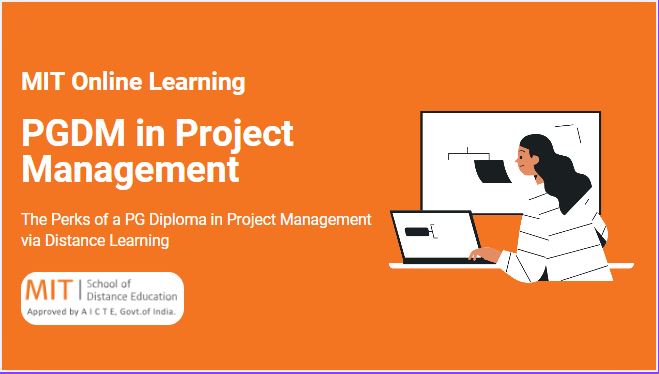
The Executive MBA and a PGDM program are two of the most popular programs among students seeking to advance in the field of business management and administration. With the dynamics of business evolving due to technological advancements, India has adapted to these significant changes by introducing young minds and working professionals to advanced management courses, such as Executive MBA and PGDM programs.
While the topic of MBA vs PGDM is a lengthy one, it is crucial to understand that these two courses have helped working professionals advance in their careers and take on leadership roles that are essential for tackling the challenges of their respective industries with confidence.
These courses not only help students develop academic knowledge on the nuances of the business world but also allow them to experience the complexities of the industry via a plethora of live and capstone projects. With more and more employers seeking to hire individuals with a diverse range of skills, PGDM and MBA programs are ensuring that the students are well-equipped with all the necessary skills to become reliable leaders of tomorrow.
In this article, we aim to help parents and students understand the significant differences between Executive MBA and PGDM programs. We also aim to provide insights into the many ways that PGDM and MBA programs are shaping the business administration, management, and operations industry, as well as understanding what makes these two advanced courses popular among industry leaders.
Let us now look into a few key differences between PGDM and Executive MBA programs.
Key Differences Between PGDM and Executive MBA
While both MBA and PGDM programs aim to provide students with adequate knowledge and skills to tackle the nuances of various industries that rely on business, operations, and financial management, there are a few differences worth looking at to help you make the right choice before choosing a course.
Eligibility Criteria – One of the key factors to consider when comparing the Executive MBA and PGDM program options is the eligibility criteria. While both courses require the students to have a Bachelor’s degree from a recognised university with aggregate marks of at least 50%, a few MBA colleges prefer students to have at least 3-15 years of working experience to reap the full benefits of the executive program.
Program Duration & Format – An Executive MBA program’s course duration is 12 -21 months, whereas a PGDM program is an extensive 2-year course. Students in an MBA program are typically assessed on their knowledge through monthly and yearly exams. A PGDM program’s testing pattern assesses students on the application of their skills through live and capstone projects, as well as periodic tests.
Pedagogy & Curriculum Focus – The PGDM program focuses on equipping students with practical skills and provides them with extensive industry exposure. An Executive MBA, on the other hand, focuses on imparting to aspirants relatively more theoretical knowledge, providing them the confidence to tackle the nuances of a diverse range of industries.
Peer Group & Networking Opportunities – Both advanced management courses offer students numerous networking opportunities through seminars, workshops, and guest lectures. The PGDM program also excels in connecting students with peer groups and industry experts through live, capstone projects and extensive industry exposure, giving the course significant weight when compared to an MBA program.
Affiliation – Executive MBA programs are offered by many universities nationwide and fall under the purview of the University Grants Commission (UGC).
A PGDM program, on the other hand, is provided only by autonomous colleges; however, the
Post Graduate Diploma Certificate is recognised by the All India Council of Technical Education. A certificate from the AICTE carries the same value as an MBA certificate, making a PGDM program remain on par with an MBA program.
Fees & ROI – When comparing Executive MBA vs PGDM programs, the fees of each course become the most crucial factor. The course fee of a PGDM course is relatively more affordable than that of an Executive MBA program. The fee for a PGDM program starts from INR 1.5 Lakhs, whereas the cost of pursuing an MBA program starts from INR 4 Lakhs.
Considering the fees and the duration of the course, the return on investment for both programs is feasible, with a slight edge to the PGDM program.
With this information in mind, let us now examine why an Executive MBA is considered the most effective option for mid-career growth in detail.
How Executive MBA Elevates Mid-Career Growth?
A few factors on how an Executive MBA elevates mid-career growth are –
Flexible Upskilling Option – MITSDE and other top colleges offer the Executive MBA program as an online course, allowing working individuals to upskill themselves over the weekend or after work hours from the comfort of their own homes.
Holistic Skill Development – Through an Executive MBA program, students can develop new skills and refine their existing ones, becoming confident individuals who can apply their skills effectively and lead dynamic teams.
Increased Networking Opportunities – Years of experience as working professionals and additional opportunities to connect with peers and industry experts through an Executive MBA program allow students to expand their connections across the industry. These networking opportunities can help aspirants advance in their careers and propel their businesses across diverse sectors with complete confidence.
Career Opportunities Post-EMBA – After completing an Executive MBA program, students with their expanded skill sets can leverage the knowledge, skills, and networking opportunities to propel their careers or businesses. Aspirants can also make use of these resources and move towards leadership roles that command leadership skills and a vast expanse of knowledge and managerial skills.
With the markets around the world now connected as efficiently as never before, thanks to today’s technology, it is imperative for advanced management courses to adapt to the current global market’s requirements. Let us now examine how current trends are influencing the overall structure of popular PGDM and MBA programs.
Trends Shaping PGDM and Executive MBA in 2025
A few trends to which advanced PGDM and MBA programs are adapting are –
Increase In Employer’s Demand For Skills – These days, international and national business houses are recruiting individuals with relevant practical skills, prompting modern MBA and PGDM programs to provide students with adequate industry exposure and means to apply practical skills even before they graduate.
Advent Of AI & ML – Artificial Intelligence and Machine Learning are two of the most happening skills in today’s day and age, making it crucial for students, irrespective of their educational background. Colleges offering PGDM and EMBA programs are now equipping students with the necessary knowledge and tools in AI and ML to help them stay ahead of the curve and become industry leaders of tomorrow.
Creating Leaders Of Tomorrow – One of the most essential skills for any management student to have is leadership skills. Top colleges like the MITSDE focus on developing leaders of tomorrow by equipping students with a plethora of soft skills apart from academic and industry-required skills. Steps like these help students develop other complementary skills such as critical thinking, logical reasoning, and creativity, among others.
Adaptivity to Hybrid Work Modes – With remote working becoming the new norm, it is critical for students to adapt to working in a hybrid model. Industry experts urge PGDM and MBA course providers to equip students with the necessary skills to handle technology and thrive in this work mode.
Industry Tip-Ups & MOUs – Colleges are actively connecting with businesses across borders to provide students with better opportunities. PGDM and MBA colleges are now boosting the placement chances of their students by providing them with relevant practical skills through networking with top companies via industry tie-ups and MOUs.
Global Exposure – The new-age Executive MBA and PGDM programs are now crafting their courses with an international perspective, providing students with opportunities to network with their peers across borders, thereby increasing their chances of being part of a global workforce.
International Student Exchange Programs offered by top colleges are now allowing young minds to explore the diversity of the business world across borders as part of their academic pursuits.
This initiative allows students to understand the benefits of having varied perspectives and how simple yet diverse ideas from different groups of people with dynamic perspectives can help solve complex challenges of various industries across the globe.
Focus On A Sustainable Future – Globalisation has made the world a smaller place, and with grander ambitions, we have forgotten our responsibility to society and Mother Earth. Top institutions like MITSDE are now focusing on teaching students the importance of sustainable business practices and, as leaders of tomorrow, how they can apply these changes to be part of a sustainable future.
These trends are not only revolutionising the country’s education infrastructure, but also helping to make our students reliable and confident young individuals with all the relevant skills and knowledge to tackle global challenges!
These modern requirements have prompted colleges to develop more diverse courses, giving rise to programs like MITSDE and Avantika University’s PGDM Executive + EMBA program.
Revolutionary Dual Specialisation Program – MITSDE X Avantika University
While we discussed PGDM vs Executive MBA in detail, MITSDE and Avantika University have come together to offer our students the opportunity to experience and take full advantage of the best of both worlds.
Our Dual Specialisation program offers students the opportunity to experience the curriculum of an MBA program while giving equal importance to practical skills, enabling them to gain adequate industry knowledge and the means to apply their skills effectively.
The specialisation program focuses on the holistic development of our students, striving to make them confident individuals with a toolbox of diverse skills and general and niche knowledge.
In our program with the reputed Avantika University, we aim to equip our students with all the necessary means to help them navigate through the complexities of their respective industries, making this dual specialisation a game-changer in terms of meeting every industry’s expectations in terms of confidence, skills and knowledge.
To understand more about our PGDM Executive + EMBA course, click here.
We hope we have helped you understand the differences between PGDM and an Executive MBA program to help you make a choice that suits your needs and aspirations better.
We have discussed in great detail the many aspects of a PGDM program and an executive MBA program. The article further explores how pursuing an executive MBA can help achieve mid-career success and examines the various trends shaping advanced management programs. For more educational articles like this, visit our website or click here.
Frequently Asked Questions (FAQs)
1 – What is the main difference between a PGDM and an Executive MBA?
Ans – One of the main differences between PGDM and an Executive MBA is their approach to the course structure.
A PGDM program has an evolving course structure that keeps adapting to industry standards and requirements, whereas an MBA program has a more rigid course structure.
2 – Who should choose a PGDM course?
Ans – A graduate from any discipline who wants to upskill themselves with relevant skills and is looking to start or grow in their careers in dynamic industries can choose a PGDM program.
3- Who should choose an Executive MBA?
Ans – Any graduate or working professional looking to upskill themselves can choose an executive MBA program to start or advance their career.
4 -Is a PGDM equivalent to an MBA?
Ans – Yes, the certificate after graduating from a PGDM or an MBA program carries the same weight when searching for a job.
5 – Which one is more expensive: PGDM or Executive MBA?
Ans – When thinking about an executive MBA vs a PGDM program, executive MBAs are relatively more expensive.
6 – How does work experience factor into the decision?
Ans – Anyone with work experience prefers an executive MBA program, whereas anyone with a bachelor’s degree, irrespective of work experience, can pursue a PGDM program.
7 -What is the ROI of a PGDM vs an Executive MBA?
Ans – The return on investment for both programs is positive, and the turnaround time on the investment is also shorter compared to other higher education programs.


